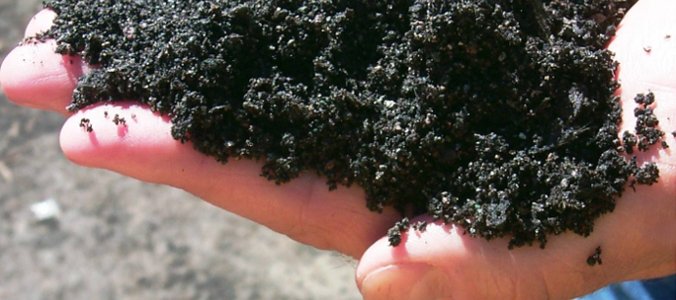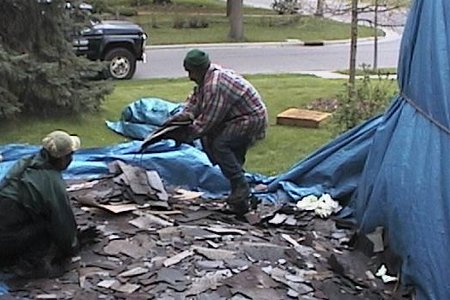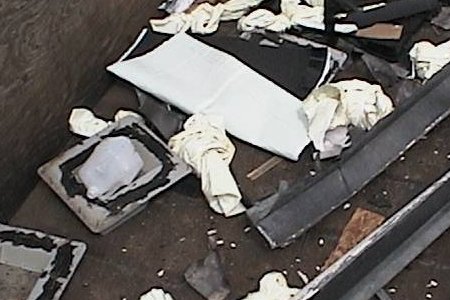
An Interview With Dan Krivit of Foth Infrastructure & Environment, LLC.
Dan Krivit is a shingle recycling consultant who works with private and public organizations to advance the state of shingle recycling. He has worked with shingle recycling companies to develop systems and specifications for the use of recycled asphalt shingles (RAS) in asphalt paving mixes.
Rotochopper
What do you see as the biggest obstacle for growth of asphalt shingle recycling?
Dan Krivit
Shingle recycling has had an upward trendline even through the recession. There are certainly challenges, but they have more to do with perceptions than actual limitations. The major challenges are closely related to one another:
1. State and provincial DOT engineers adopting tear-off permissive specs. This is a very slow climb.
2. Environmental issues (particularly asbestos). The fear over asbestos is a barrier—and it’s used as a barrier. DOT engineers and EPA regulators are rightfully concerned about maintaining high standards for quality and safety. But in some cases, these common fears are used as distractions from the real issues and solutions. Asbestos testing consistently has demonstrated a very low occurance rate of asbestos in asphalt shingles, well within safe limits. Most of the other environmental concerns really just come down to management issues. Shingle recyclers need storm water plans. They need to carefully implement systems for protecting air quality and so on—just like any recycling or materials processing operation. But all of these concerns are manageable, just like asbestos is a very manageable challenge.
Pictured at left: Resurfacing a road with hot mix asphalt pavement that contains 5% recycled asphalt shingles (RAS).
Rotochopper
What do you identify as the biggest challenge for companies starting shingle recycling operations?
Dan Krivit
Securing a clean supply of shingles. Every shingle recycler—whether it’s a hot mix company owning a grinder and running a vertically-integrated recycling operation or a roll-off company sorting tear-offs from construction & demolition debris and selling RAS to a hot mix plant—has to ensure a steady, clean supply of shingles. Which is not to say that this challenge should be a deterrent. On the contrary, for some companies, this challenge turns out to be the factor that distinguishes them from the competition. It’s one of the factors that ensures that multiple companies profit from the handling, sorting, grinding, and end use of shingles.
For instance, some shingle recyclers are offering lower tipping fees or no tipping fees to roofing contractors that source separate tear-offs. Everyone from homeowners to waste handling companies can benefit from this drive toward clean shingle supplies.
Obviously capital is tight right now, and obtaining financing can be a longer process. But shingle recycling companies have a strong record of profitability and getting financing.
Pictured at right: During a re-roofing project, tear-off shingles are source separated from other waste materials, such as tar paper, wood, and flashing. Source separating shingles may reduce disposal costs
because the clean tear-offs require little to no sorting prior to grinding.
Rotochopper
Within the asphalt paving industry—the largest single end market for RAS—a number of cost-saving practices and technologies are increasing in popularity, including shingle recycling and warm mix
asphalt technologies. Do you anticipate warm mix technologies having any effects on further adoption of shingle recycling within the asphalt paving industry?
Editor’s note: Warm mix technologies allow asphalt paving materials to be mixed, handled, and applied at lower temperatures than traditional hot mix plants, offering significant savings on heating costs.
Dan Krivit
RAS can be used with warm mix. Warm mix is still going through a shakedown, with some of the competing technologies coming out on top and some going away. That will take time to work out. In three to five years, warm mix will be becoming more of the standard than the exception. The savings of warm mix technology are proving to be worth the investment, just like shingle recycling. The ongoing question is going to be: what percentage of binder will be replaced by the RAS added to a paving mix? Mix design engineers are like brewmasters. Warm mix technologies and RAS are just additional variables that need to be dialed in.
For years, the asphalt industry has been promoting the compatibility of green technologies, like RAP (recycled asphalt pavement) and RAS (recycled asphalt shingles). Few industries come close to the track record of recycling that the asphalt paving industry has been developing for a few decades. Few industries have been able to lower their carbon footprints like the paving industry has. Asphalt companies are fond of citing the statistic that asphalt paving is the most recycled material in the US. The asphalt industry is very effective at creating the technology to make increased recycling possible—because the savings are well worth the R & D.
Pictured at right: Roofing waste materials that have been source separated from tear-off shingles, including metal flashing, roof underlayment scrap, vents, and wood waste. DOT specifications for using RAS in paving materials typically allow for only miniscule percentages of foreign (deleterious) materials like wood, plastic, and metal.
Rotochopper
Currently, a high percentage of the companies recycling shingles are involved in the asphalt paving industry, although RAS has also proven a valuable material for other applications, like boiler fuel or cold asphalt repair. Do you anticipate the market breakdown changing within the next few years?
Dan Krivit
Within the next five years, I think the mix of markets will stay essentially the same. The R & D and applications of shingle recycling within the asphalt paving industry surpass any other market for RAS. So the paving industry will be the focus for RAS within the foreseeable future. That’s the way it should be, I think, because it’s providing a very strong market for a growing recycling application.
Plus, clean shingle waste can be directly incorporated into a paving mix once it’s in a fine texture form. It doesn’t require any chemical treatments or other processes. It may have sand added to it to prevent agglomeration or it may need to be de-lumped if it does agglomerate prior to use. But essentially it doesn’t require anything beyond getting it and keeping it in a fine texture form.
The value of the AC (asphalt cement) in shingles will continue to grow. One company is currently developing extraction processes for separating the liquid asphalt cement from the solid materials in shingles. If this extraction method is commercialized, shingle recyclers may be able to produce a value-added commodity, recycled liquid asphalt, that can start competing with solid RAS. But until then, solid RAS in paving mixes will be the norm.
Of course, there are other applications, like cement kilns using RAS as an alternative fuel. These alternative fuel uses are not yet competitive with other lower cost waste and coal products.
Using RAS in cold mix pavement repair has also proven technically feasible and successful. Compared to hot mix asphalt paving, however, cold mix applications are not getting the full value of the AC in the shingles.
Pictured at right: A blended mix of RAP (Recycled Asphalt Pavement) and RAS is conveyed into a continuous flow HMA drum, where it is mixed with aggregate and virgin asphalt cement. The materials are heated to cause the asphalt cement to bind to the aggregate.
Rotochopper
Regarding the previous question, do you anticipate a shift in the type of companies involved in shingle recycling?
Dan Krivit
I think we will see more vertical integration within hot mix asphalt companies. In many cases, hot mix plants don’t want to deal with testing for asbestos or the additional process of grinding; they want to contract that out to other companies. (Which goes back to the issue of perceptions vs. actual challenges.) In states such as Missouri, Wisconsin, Massachusetts and Minnesota, hot mix producers have been grinding for years. These states are ahead of a lot of the other states in this regard. I think we’ll see a trend toward more vertical integration as hot mix plants realize that asbestos testing and shingle grinding are very manageable.
Hot mix plants want to control quality. As mentioned earlier, they take great care to dial in their feedstock materials very precisely. The key issue is, how to gain control over the supply of both the raw material and the quality of the finished RAS product. For many hot mix producers, the best way to control the supply of RAS is to make it themselves.
But basically, we are obviously going to see more types of companies involved in RAS because, other than the 1 million tons of factory rejects generated each year, shingle scrap isn’t centralized, which allows different kinds of companies to profit from it—roofers, waste handling companies, shingle grinding contractors, not just hot mix companies.
But, regardless of who is grinding the shingles, the hot mix plants are driving the growth of shingle recycling because the cost savings for them are so significant.
Rotochopper
While the majority of RAS is derived from factory rejects, tear-off recycling is gaining momentum. How do you see this shift affecting end markets and the types of companies involved in shingle recycling?
Dan Krivit
It will diversify the players greatly. If there’s a shingle manufacturing facility that does not have an immediate outlet for recycling yet, there’s a local market problem. Most of the growth will be in tear-offs. More state DOTs writing permissive tear-off specs will create an explosion of supply (tear-offs represent about ten times the amount as factory rejects). Unlike factory rejects, this supply is decentralized. Tear-off grinding will allow for smaller companies handling smaller volumes.
The use of tear-offs won’t change the market dynamics—it will still be focused on hot mix. The increased use of tear-offs will increase competition, which will only benefit the market.
Pictured at right: Clean shingles that are ready for grinding.
Rotochopper
To wrap up our discussion, what would you like to see happen in the next few years regarding shingle recycling?
Dan Krivit
1. The growth of shingle recycling comes down to entrepreneurial creativity. It’s essential that state and provincial engineers write permissive (not mandatory) specs for shingle recycling, of course, but it’s the profitability of RAS that is driving the growth. Hot mix companies, roofing contractors, waste handling companies—the private sector—is pushing forward and creating the opportunities.
2. The significant growth will come with more states writing specs for tear-offs—not just provisional specs but permissive specs that encourage a long-term outlook for the recycling of tear-offs.
3. Having a DOT spec for RAS is not enough. The protocols for asbestos identification, sampling, and testing set by state environmental regulators need to be more standardized to allow for easier handling of tear-offs while actually helping the industry to manage real risks, not just perceived risks.
4. More involvement by shingle manufacturers. The example set by Owens Corning is impressive. It’s helping to create a shingle recycling mindset, from the consumer to the roofing contractor to the roll-off company.
Several states in the US are on verge of implementing specs for RAS after extensive testing. Some of the states that are currently allowing factory rejects are developing specs for tear-offs. The outlook for shingle recycling has never been better.
Rotochopper
Thank you for joining us today.
Dan Krivit
Thank you for the opportunity to promote awareness about shingle recycling.
***
By
Monte Hight
All pictures provided courtesy of Dan Krivit.
For more information about shingle recycling requirements and markets in your area, contact your
regional Rotochopper rep.
Dan Krivit | Foth Infrastructure & Environment, LLC | Senior Project Manager
Foth Infrastructure & Environment, LLC
Phone: (651) 288-8509 | Email: Dan.Krivit@Foth.com






